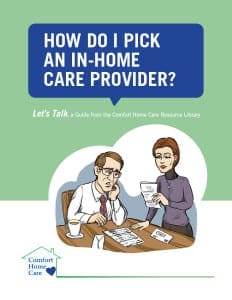
Parkinson’s disease progresses gradually, and can start with something as seemingly minor as a tremor in the hand. It is also unfortunately incurable, although treatments are available that can help ease the symptoms. Parkinson’s is an illness which can be truly detrimental for sufferers as well as their loved ones. Easing the burden of Parkinson’s is something which usually involves the commitment of the entire family.
Because it is a progressive disease with no specific cure, Parkinson’s impacts daily life more and more over time. The more developed the disease becomes, the greater the difficulties that may arise with regards to even the most basic of tasks. The activities of daily living, also known as ADLs, can become a mountainous task to those who suffer with Parkinson’s. It frequently becomes the responsibility of their family and other loved ones to help out where and when necessary, but as the disease progresses it is highly recommended to consider hiring professional help.

In order to consider what level and type of care to provide for an aging relative, it is helpful to take into account the common symptoms often associated with Parkinson’s disease. These symptoms are typically divided into two categories: motor and non-motor.
Motor Symptoms of Parkinson’s Disease
Physicians diagnose Parkinson’s by assessing the visibility of one or more of the following motor symptoms:
Tremors
When a person with Parkinson’s is stationary, there is often the appearance of a slow, rhythmic tremor on one of the limbs: it can start in the hand, foot or leg. Less often this same tremor can be seen around the mouth area; particularly around the jaw, chin, mouth, or tongue.
Rigidity
Rigidity is a symptom that is not restricted to Parkinson’s, so it can often be mistaken as something else (arthritis, for example). Rigidity in Parkinson’s disease involves a stiffness of the limbs or torso.
Bradykinesia
Bradykinesia is a term that originates from the Greek phrase meaning ‘slow movement’. Slow movement in general is a common symptom of Parkinson’s, and is often coupled with what’s known as ‘facial masking’. Facial masking is when the muscles in the face freeze, or become immobilized. This expressionless face is a sure sign of Parkinson’s. Moreover, patients can also exhibit symptoms that include reduced blinking of the eyes, and a problem with fine motor coordination ( adjusting a tie, tying a lace, or buttoning a shirt, for example). Other signs of the general slow movement symptom is a difficulty or slowness when changing position in bed, and diminished writing speed.
Postural Instability
Postural instability is a symptom that usually manifests when the disease has progressed to a later stage. Sufferers can have difficulty remaining steady and upright, and can be prone to leaning backwards: a light push could cause a Parkinson’s patient in the later stages to fall down backwards, making regular check-ins extremely important for their wellbeing.
Walking or Gait Difficulties
One key sign of Parkinson’s disease is someone walking without swinging arms. General walking or gait difficulties are a common symptom of Parkinson’s, and in later stages their steps become slow and small, often resembling a shuffling pace. In the very advanced stages, their feet may even become frozen in place, almost as if they are glued to the floor.
Vocal Symptoms
A person with Parkinson’s can demonstrate symptoms that impact their speech, and voice. Their voice could be softer, it could be loud and then fade to quiet relatively suddenly, and the voice often loses the intonations that give it animation. Thus, a Parkinson’s sufferer may speak at a single, even tone, known as a monotone. Stuttering and rapid speaking (words falling out in a tumble) are symptoms that often appear during the later stages of the disease.
Non-motor Symptoms of Parkinson’s Disease
There are a number of non-motor symptoms of Parkinson’s disease that range from depression and anxiety, to sleep disturbance, to gastrointestinal issues. The appearance of motor symptoms are a more reliable way of diagnosing and monitoring the disease, however, because many of the non-motor symptoms could be mistaken as a symptom for another disease.
Care Options for Parkinson’s

In-home care for Parkinson’s disease can help the individual to retain a high quality of life, and remain as independent as possible. When hiring professional caregivers, it is recommended that you check their hiring procedures. Concerned family members will no doubt want to be assured that the people frequenting their relative’s home is of good moral standing, and professionally trained. Thorough hiring procedures including criminal background checks and assessment of qualifications will help to establish a bond of trust between the professional carer, the person in need of care, and their surrounding family and friends.







